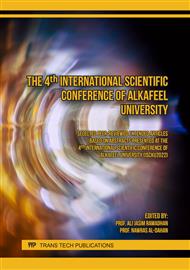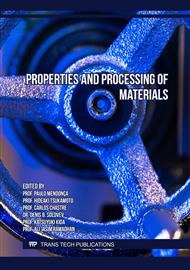[1]
Zaid K. Alkaabi (2021). Synthesis and Characterization of ZnO Nanoparticles via Aloe Vera Extract. Materials Science Forum. 1039, 269-273
DOI: 10.4028/www.scientific.net/msf.1039.211
Google Scholar
[2]
H. Maeda, Y. Tanaka, M. Fukutomi and T. Asano, Jpn. J. (1988).Appl. Phys. 27, L209
Google Scholar
[3]
M.S. Shalaby, H.M. Hashem, T.R. Hammad, L.A. Wahab, K.H. Marzouk, S. Soltan , (2016).Higher critical current density achieved in Bi-2223 High-Tc superconductors, Journal of Radiation Research and applied science 9 ,345-351
DOI: 10.1016/j.jrras.2016.04.001
Google Scholar
[4]
Zaahidah 'Atiqah Mohiju, Natasha Alieya Adnan, Nasri A. Hamid, and Yusof Abdullah(2018) . Phase formation and microstructure of gamma irradiated Bi-2223 Superconductor Materials Science and Engineering 298 012021
DOI: 10.1088/1757-899x/298/1/012021
Google Scholar
[5]
V.Grnier,R.caillard,G.desgardin,(2001) (Bi−Pb)2Sr2Ca2Cu3O10+6 ceramic synthesized using a polymer matrix method, Journal of the European Ceramic Society 21, 1139−1142
DOI: 10.1016/s0955-2219(00)00338-1
Google Scholar
[6]
N. Ichinose and h. Maiwa , 1989.preparation of superconducting oxide thick films in the Bi-Sr-Ca-Cu-0 system , Gordon and Breach Science Publishers. 92, 159-166
DOI: 10.1080/00150198908211321
Google Scholar
[7]
Kassim M. Wadia, Aqeel N. Abdulateefa, Auday H. Shabanb, Kareem A. Jasimb (2019). Improvement of superconducting Heating and Cooling Bi2Ba2Ca2Cu3O10+δ Ceramic by prepared under different pressure, Energy Procedia 157, 222-227
DOI: 10.1016/j.egypro.2018.11.184
Google Scholar
[8]
Suazlina, M. A., Yusainee, S. Y. S., Azhan, H., Abd-Shukor, R., & Mustaqim, R. M (2014). The effects of nanoparticle addition in Bi-2212 superconductors. Jurnal Teknologi (Sciences and Engineering). 69(2), 49-52.
DOI: 10.11113/jt.v69.3106
Google Scholar
[9]
Patel, R.H., Nabialek, A, & Niewczas, M. (2005) Characterization of superconducting properties of BSCCO powder prepared by attrition milling. Superconductor Science and Technology, 18, 3
DOI: 10.1088/0953-2048/18/3/019
Google Scholar
[10]
Xiaoming Lu,Tianlin Wang,Yang Qi (2016). Crystalline characteristics and superconducting properties of Bi2212 thin films by Pechini sol–gel method: effect of heating rate on the film growth, J Sol-Gel Sci. Technol Journal of Sol-Gel Science and Technology 77, 100 –108
DOI: 10.1007/s10971-015-3834-x
Google Scholar
[11]
Somani, V. and Kalita, S. (2007) Synthesis and characterization ofnanocrystalline Barium Strontium Titanate powder via sol-gel processing . J .Electroceram 18, 57–65
DOI: 10.1007/s10832-007-9008-7
Google Scholar
[12]
Zhang, Shi Chang, Gary L. Messing, and Wayne Huebner. "YBa2Cu3O7− x Superconductor powder synthesis by spray pyrolysis of organic acid solutions." Journal of aerosol science 22.5 (1991): 585-599.
DOI: 10.1016/0021-8502(91)90014-9
Google Scholar
[13]
Zaid K. Alkaabi and Emad K. Al-Shakarchi (2021). Studying the physical properties of bi-2223 nanostructure prepared thermal treatment method. Materials Science Forum, 1039, 269-273
DOI: 10.4028/www.scientific.net/msf.1039.269
Google Scholar
[14]
Arlina Binti Ali, Abdul Halim Shaari, Chen Soo Kien and Julie Juliwaty Mohamed, Synthesis and Characterization of Magnesium Diboride Additions of Bi-2223 on the Microstructure and Superconducting Transition. Solid State Phenomena, 290, 233-238
DOI: 10.4028/www.scientific.net/ssp.290.233
Google Scholar
[15]
S. Lee, A.yamamoto, and S.Tajima. fast Synthesis and single crystal growth of Pb-free and Pb doped Bi-2223 Superconductor using alkali chlorides flux technique, physica c (2001), 341-344
DOI: 10.1016/s0921-4534(01)00242-8
Google Scholar
[16]
S. Koyama, U. Endo and T. Kawai, (1988) "Preparation of Single 110 K Phase of the Bi-Pb-Sr-Ca-Cu-O Superconductor," Japanese Journal of Applied Physics, 27, L1861-L1863
DOI: 10.1143/jjap.27.l1861
Google Scholar



